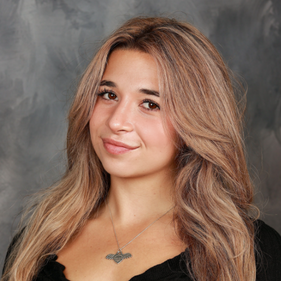My Limitless Identity

In elementary school, I learned about circles. I learned about the circle’s center. I learned about the radius, which connects the center of the circle to any point on the outside. And most memorably, I learned about the diameter — the line that splits the circle right down the middle.
I’ve always thought of myself as a circle. As someone who grew up with a Jewish father and Catholic mother, this round shape helped me explain my identity. If I were ever to sketch my circle, I’d have to draw a diameter because I’m only half Jewish…Right?
Being raised in an interfaith family meant that each part of my identity had its designated place in my circle. They even had separate rooms in my house.
Hanukkah was always celebrated in our living room, while Christmas was always celebrated in our den. I never thought twice about this separation. It felt natural to leave part of my identity behind as I walked from room to room, just to be confronted with the other part of me.
During the holiday season, I looked forward to lighting the menorah with my family. My brother and I would scurry to the carpet, bury our faces in our knees, and wait for my dad to yell, “Release!” before tearing our gifts open. I also looked forward to the smell of fresh pine in our den, courtesy of our Christmas tree. Every year, my family set out to find the perfect Christmas tree and decorate it with lights and ornaments. Our den would burst with holiday colors and aromas all month long.
Each celebration had a time and place, meaning I needed to bury part of my identity when entering a faith-oriented space. Or so I thought. I was constantly in a mental tug-of-war with my identity when I should’ve been embracing and celebrating every part of myself.
The bottom line: I needed to reimagine my circle so I could be my full, authentic self. No matter the time. No matter the place.
I finally began appreciating my intersectionality when I started college at University of California, Santa Barbara. I was shocked to find a vibrant hub for Jewish life at Santa Barbara Hillel.
At Hillel, I learned to walk into a room as my whole self, never leaving part of my identity behind. I was finally Jewish enough. For so many years, I created walls because I came from an interfaith family. Hillel taught me that my intersectionality was an asset in Jewish spaces, as it taught me to be open-minded, understanding, and compassionate.
I was able to bring a unique perspective to my Hillel community, and I wanted to bring that perspective to more Jewish communities.
The best way for me to do that: writing.
I applied for the Hillel International Writers Program, a yearlong opportunity for students interested in storytelling. This year, I’ve been able to interview students and tell their stories. The program allows me to connect with people who want to celebrate being multifaceted and those who don’t quite see the beauty in it yet. I love encouraging others to appreciate their identity.
And now, I want to encourage you. If you only have one Jewish parent or grandparent, you bring a unique perspective to your own community. If both of your parents are Jewish, you have agency to help others embrace their Judaism, no matter what their circle looks like.
After all, identity isn’t rigid. I still identify with a circle, but my understanding of who I am has evolved. I’ve learned that having one Jewish parent doesn’t make me “less” Jewish. Being Jewish is part of who I am, and in turn, I am part of my Jewish community. Even though I have one Jewish parent, my Judaism is completely valid.
If I were to sketch my circle now, it would represent being limitless. There would be no diameter, sharp lines, or boundaries to silo different parts of myself; the parts that come together to make me, me. I am defined by an infinite and smooth curve. Every part of my identity is integral to my circle. Every part of my identity makes me whole.